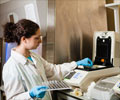Genetic testing for eye disease is providing vital information about complex retinal diseases, especially when used to confirm a clinician’s diagnosis.
Genetic testing for eye disease is providing vital information about complex retinal diseases, especially when used to confirm a clinician’s diagnosis.
In a newly published review of such tests that were conducted over a five-year period at the University of Michigan Kellogg Eye Center, scientists were able to confirm a clinician’s diagnosis in half of the cases. The testing took place in the laboratory of Radha Ayyagari, Ph.D., director of Kellogg’s Ophthalmic Molecular Diagnostic Laboratory.In the February issue of Archives of Ophthalmology, Ayyagari and her colleagues report on 350 genetic tests conducted since 1999, when the U-M Ophthalmic Molecular Diagnostic Laboratory became one of the first laboratories in the nation to receive government approval for ophthalmic testing under the Clinical Laboratory Improvement Amendment (CLIA). For each test described in the current study, scientists analyzed one or more of eight genes known to cause diseases of the retina.
Of the 350 tests, 266 were performed to confirm a clinician’s diagnosis, by far the most common use of genetic testing for eye disease. Another 75 tests sought to determine whether an individual was a “carrier” of a disease, and nine tests were used to predict the likelihood that an individual with a family history of a given eye disease would go on to develop it.
Ayyagari’s team was able to determine the molecular basis of the disease in half of 266 tests conducted to confirm a diagnosis. These results are significant because many retinal diseases present similar symptoms, and it is sometimes difficult for even the most skilled specialist to distinguish one from the other. By comparing a patient’s DNA to known disease-causing genes, scientists deliver information needed to confirm or rule out a diagnosis. To date, scientists have identified over 130 genes associated with retinal disease, such as retinitis pigmentosa and macular degeneration.
The authors observe that genetic testing for eye disease is a relatively new and evolving practice. Says Ayyagari, “Molecular diagnostics does not replace the necessary expertise of the ophthalmologist; rather, it adds a new tool to the ophthalmologist’s diagnostic arsenal.”
The report describes one case in which parents with no family history of retinal degeneration requested genetic testing in hopes of revealing the specific nature of their son’s eye disease. They also wanted to know whether the younger son, who was experiencing more subtle symptoms, had the same disease or a milder vision problem due to a different disease. Testing revealed that both boys had two gene mutations linked to Stargardt’s macular degeneration, a blinding disease that begins in childhood.
Advertisement
The study also reported that a diagnosis could not be confirmed in 133 cases, or half the tests conducted to confirm a diagnosis. “It is very difficult for patients to understand that the test may not be definitive,” says Ayyagari. “Genetic testing may not always yield the firm facts we receive in other kinds of testing, such as blood tests for cholesterol levels.”
Advertisement
“Tomorrow we may discover a new gene that explains many of the previously inconclusive test reports,” says Ayyagari.
In a related paper in the same issue of Archives of Ophthalmology, Stephen Daiger, Ph.D., University of Texas Health Science Center, writes on the promise of genetic testing for eye disease. He says, “Across all of the categories of inherited retinopathy, careful screening of known disease genes leads to detection of pathogenic mutations in 25 percent to 90 percent of patients, an extraordinary accomplishment.”
It is to the patient’s advantage to have a molecular diagnosis on file, observes Ayyagari. “When treatments begin to emerge for these complex genetic diseases,” she says, “the individual’s genotype may determine whether a new treatment will be the one that works for that patient.”
Source-Newswise
SRM











